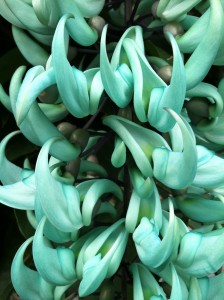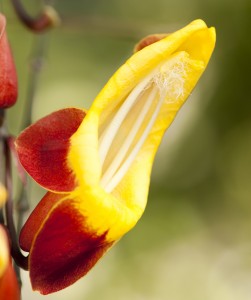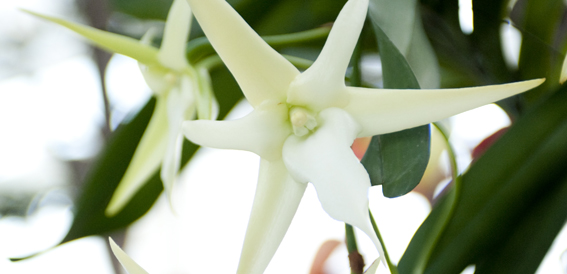Colors of the Conservatory
Posted in Around the Garden on March 12 2013, by Sonia Uyterhoeven

I recently spent an early morning walking around the Enid A. Haupt Conservatory, soaking in the tropical colors and exotic flavor in the display houses before the crowds came in for The Orchid Show.
One of my favorite late February, early March features in the Conservatory is the electric blue-green of the blooming jade vine (Strongylodon macrobotrys). The jade vine is indigenous to the Philippines, where its tendrils scramble up tropical rain forest trees in an effort to seek out sunlight. The beak-like flowers dangle from a long raceme that can extend for several feet (the flower inflorescences can reach up to nine feet in the wild). The mint-green color of the flowers is almost eerie, and something that needs to be seen in person to fully experience. These flowers are pollinated by bats in their natural habitat, and produce large, melon-like fruit.
Another showy vine that is in flower at this time of year is the Mysore clockvine (Thunbergia mysorensis). This large, tropical vine also produces a spectacular display with its dangling mass of flowers. Indigenous to India, the Mysore clockvine’s common name heralds from the city of Mysore in the province of Karnataka, where its flowers have excited the imagination of many, hosting a number of descriptive titles. One common name, the “Brick and Butter” vine, is owed to its exuberant bi-colored blossom in–you guessed it–brick red and butter yellow. The common name of “Doll’s Shoes” comes from the slipper shape of the blossom, a perfect fashion accessory for your favorite poupée.

We also have a few pearls in our orchid collection that are outstanding this time of year. In the same Conservatory house as the huge tropical vines, you’ll find a large container of Laelia superbiens. Formerly called Schomberkia superbiens, this species of orchid is native to Mexico. It is a large-growing epiphytic orchid that can form dense, six-foot-wide colonies, with a flower spike that reaches up to four feet tall and sports an inflorescence with between seven and 12 flowers. The lavender-pink and white flowers look like the face of a tropical creature, opening its exotic mouth to devour you. You may even feel slightly lost looking at this magnificent orchid; it is worth seeing it in person to get a sense of its stature.
Another unusual sight in the Conservatory this year is the Madagascar Christmas star orchid, or Darwin’s orchid (Angraecum sesquipedale). This orchid has large, waxy, star-like flowers with a pronounced lip and a foot-long spur that projects from the back of the flower. Darwin hypothesized that there was a moth in Madagascar that had a foot-long proboscis (tongue) to lap up the sweet nectar that lies at the bottom of the spur. Critics at the time laughed, claiming that the famed scientist was taking his theory of evolution too far. However, 40 years after Darwin’s pronouncement, the moth was discovered. This waxy white orchid is further worth seeing, and you won’t miss the spur; the specimen is located at the beginning of the main show house, hanging from a tree.

Regardless of your personal tastes, you’re sure to find something in the Conservatory–and The Orchid Show–to stimulate your senses and inspire your imagination.

